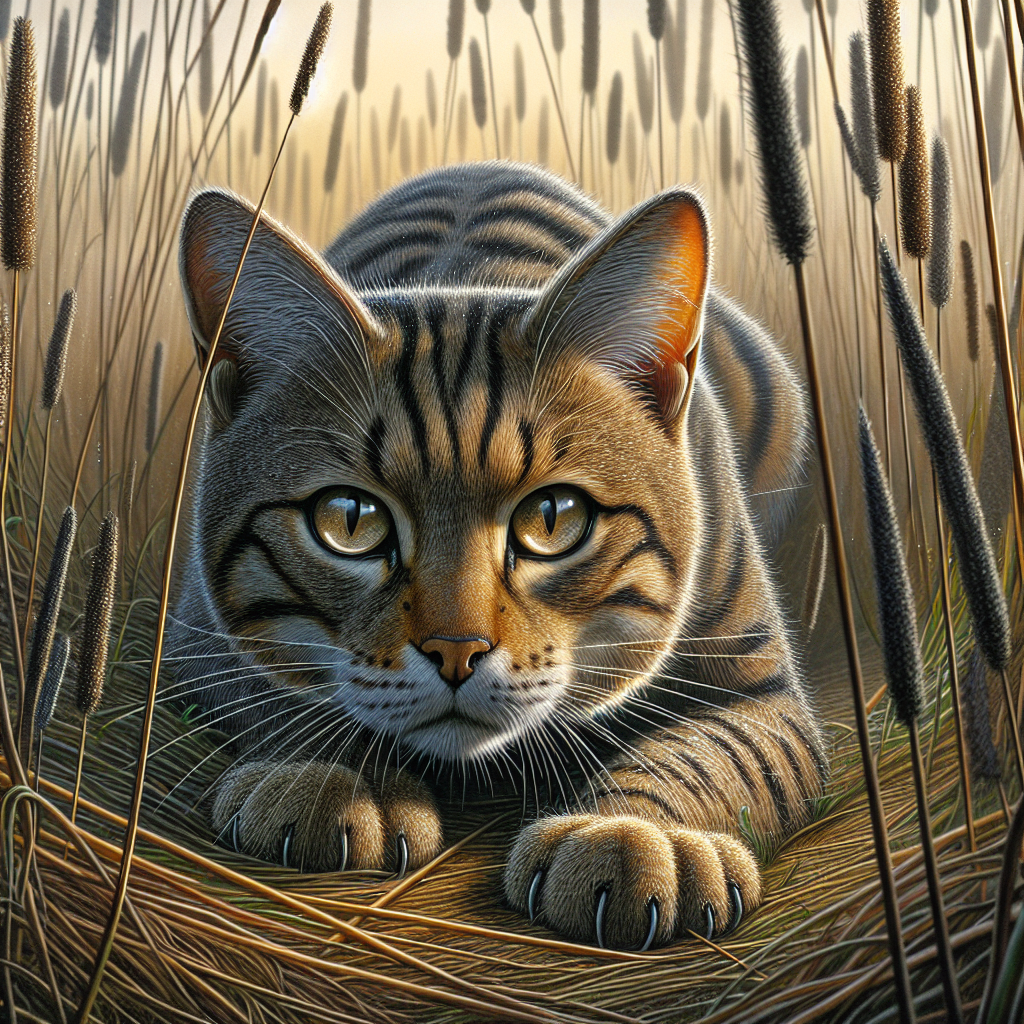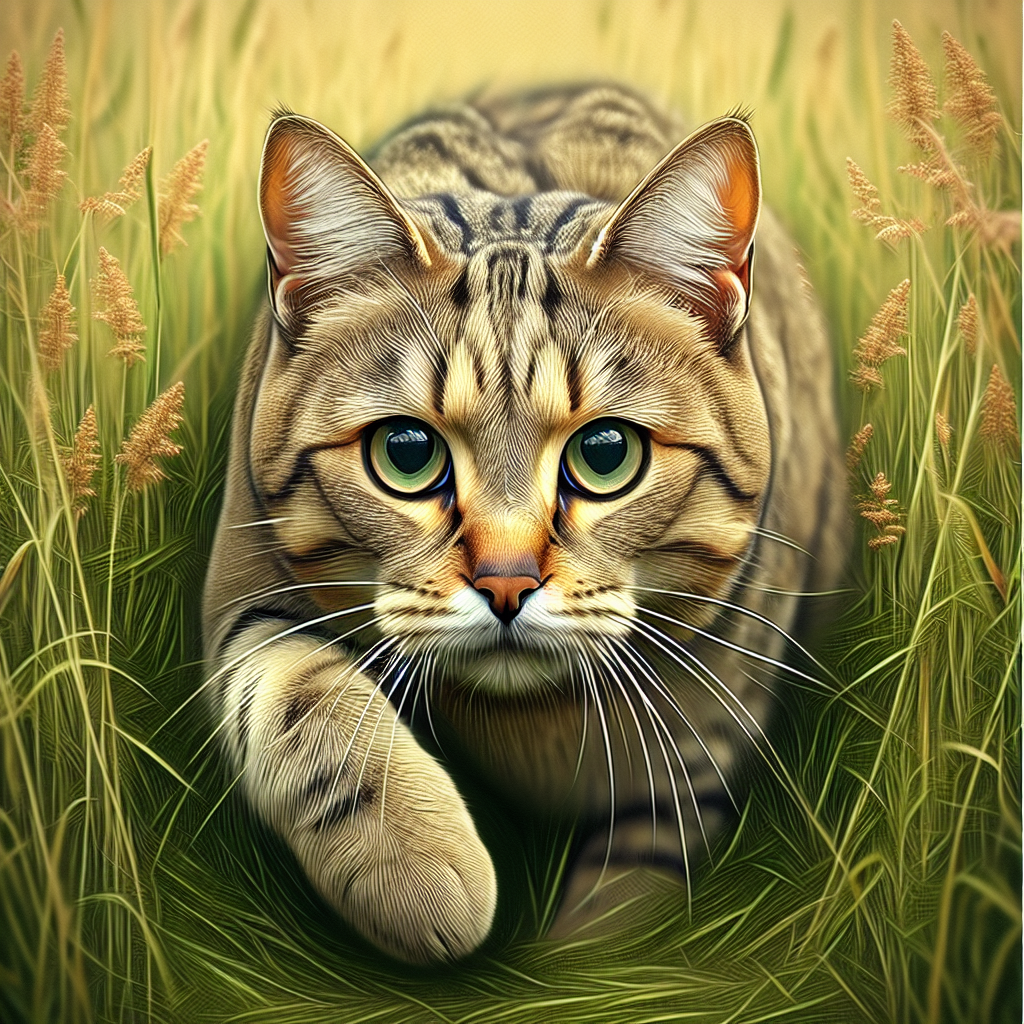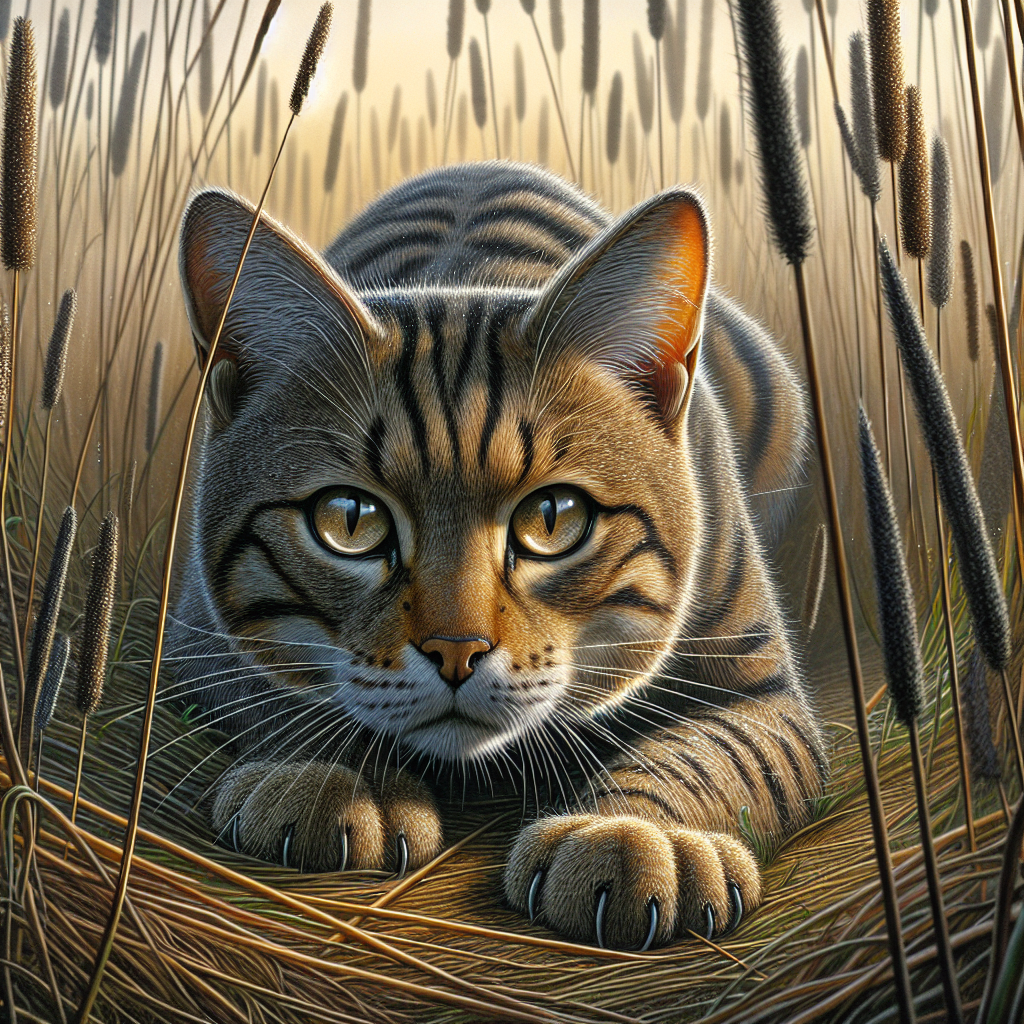Tabby cats have always been masters of the hunt, captivating us with their stealth and precision. With their keen eyesight and excellent reflexes, these feline furballs are natural-born predators. Whether it’s a toy mouse or a real one, the hunting skills of tabby cats never fail to impress. Their ability to stalk, pounce, and catch prey is a testament to their innate hunting instincts. So, if you ever find yourself with a tabby cat as a furry companion, be prepared to witness their prowess in action.
Physical Attributes of Tabby Cats
Excellent Eyesight
Tabby cats are known for their excellent eyesight, which is a key factor in their hunting abilities. Their eyes are not only large, but they also have a wider field of vision compared to humans. This allows them to spot even the slightest movements from afar, making them exceptional at detecting prey. Whether it’s a small mouse scurrying across the room or a bird flying from tree to tree, a tabby cat’s eyesight is sharp and focused.
Keen Hearing
In addition to their impressive eyesight, tabby cats also possess keen hearing that aids them in their hunting endeavors. Their ears are not only highly sensitive to sounds, but they can also swivel independently, allowing them to pinpoint the location of potential prey. This acute sense of hearing enables tabby cats to detect faint rustling, chirping, or squeaking sounds made by their targets, giving them an edge in tracking and capturing prey.
Supple Body Structure
The supple body structure of tabby cats is another physical attribute that plays a crucial role in their hunting skills. They have flexible and agile bodies, allowing them to move stealthily and with great precision. Their muscular limbs provide the necessary strength and speed for chasing down prey and executing strategic jumps or pounces. Whether navigating through tight spaces or leaping into the air, the supple body structure of tabby cats enables them to move smoothly and with ease, enhancing their hunting prowess.
Sharp Claws
Sharp claws are yet another physical attribute that contributes to a tabby cat’s hunting abilities. Their claws act as natural weapons, allowing them to easily capture, immobilize, and manipulate their prey. Tabby cats have the ability to retract their claws when not in use, ensuring they stay sharpened and ready for hunting. With their claws, they can climb trees, grasp onto surfaces, and make precise movements while hunting, ensuring that their prey doesn’t stand a chance.
Instinctual Hunting Behaviors
Stalking Prey
Tabby cats exhibit remarkable stalking behaviors when on the prowl. Their natural instinct kicks in as they carefully observe their potential prey from a hidden or elevated position. They stalk stealthily, minimizing any noises that might alert their target. Their eyes fixate on the prey, calculating distances and positions, preparing for the critical moment to strike. This stalking behavior showcases their patience and the precision with which they plan their attack.
Ambush Techniques
Ambushing is another hunting technique commonly employed by tabby cats. They utilize their surroundings to conceal themselves, patiently waiting for the perfect opportunity to surprise their unsuspecting prey. Whether hiding in tall grass or behind furniture indoors, tabby cats use careful camouflage and remain completely still for extended periods, ensuring they remain undetected until the moment is right to ambush their prey.
Pouncing Skills
Pouncing is a vital skill that tabby cats possess, enhancing their hunting prowess. Once the tabby cat has successfully stalked and closed in on its prey, it employs a quick and powerful pounce to capture its target. This skill relies on their supple body structure and sharp claws. With lightning-fast reflexes, they can launch themselves toward their prey, displaying impressive agility and precision.
Intense Focus
Tabby cats exhibit an intense focus when engaging in hunting behaviors. They concentrate all their attention on the task at hand, blocking out distractions and honing in on their goal. This unwavering concentration allows them to anticipate the movements of their prey, making split-second decisions to ensure a successful hunt. Their intense focus is a testament to their commitment and determination in fulfilling their innate hunting instincts.

Prey Preferences
Small Mammals
Tabby cats have a natural inclination towards hunting small mammals. From mice and rats to squirrels and rabbits, these furry creatures are a common target for tabby cats. Their exceptional eyesight and keen hearing are particularly advantageous when stalking and pursuing these fast-moving creatures. With their natural predatory instincts, tabby cats can efficiently track, chase, and capture small mammals as they exhibit their innate hunting skills.
Birds
Birds are another type of prey that tabby cats are drawn to. Their ability to detect slight movements and their agility in climbing trees or rooftops give tabby cats an advantage when hunting birds. Depending on the size and species of the bird, tabby cats may employ different hunting techniques, from stalking and pouncing to aerial pursuits. Their love for bird hunting often stems from their instinctual response to avian creatures and the thrill of pursuing them.
Insects and Vermin
Insects and vermin such as bugs, spiders, and even small snakes are also targets for tabby cats. They display nimble movements and swift paws as they pounce on these smaller prey items. Their sharp claws and quick reflexes allow them to capture and neutralize such creatures efficiently. Whether it’s a crawling beetle or a darting mouse, tabby cats demonstrate their diverse hunting abilities by targeting a wide range of insects and vermin.
Patience and Persistence
Extended Waiting
One of the key aspects of a tabby cat’s hunting behavior is extended waiting. They exhibit remarkable patience, often remaining still and watchful for extended periods before initiating their attack. This waiting period allows them to observe their prey, understand their behavior patterns, and anticipate the best moment to strike. Whether it’s waiting in tall grass or perched on a tree branch, tabby cats rely on their patience to ensure a successful hunt.
Slow and Steady Approach
Tabby cats are known for their slow and steady approach when hunting. They cautiously and methodically inch closer to their prey, avoiding rapid movements that may startle their target. This calculated and gradual approach ensures that their prey remains unaware of their presence, increasing the chances of a successful capture. The slow and steady approach showcases the meticulousness and intelligence behind their hunting strategies.
Tracking and Trailing
Tracking and trailing are fundamental hunting skills for tabby cats. They instinctively sniff out trails and footprints left behind by their prey, using their acute sense of smell to determine the direction their target has taken. By following these trails, tabby cats are able to close in on their prey with precision. Their ability to track scent marks or footprints showcases their exceptional tracking skills and their dedication to capturing their elusive prey.

Adaptability and Learning
Observing and Mimicking
Tabby cats are astute observers and quick learners when it comes to hunting. They often mimic hunting behaviors and techniques observed from other cats or even humans. By watching and mimicking, they add variety to their hunting strategies and adapt their techniques to different types of prey. This ability to learn from their surroundings allows tabby cats to become more versatile hunters, increasing their chances of success.
Trial and Error
Trial and error is another learning method employed by tabby cats to hone their hunting skills. They experiment with different techniques, observing the outcomes and adjusting their approach accordingly. Through trial and error, tabby cats learn which techniques are most effective for specific prey, refining their methods over time. This ability to adapt and learn from mistakes is another testament to their intelligence and natural instincts as hunters.
Social Learning
Tabby cats are known to learn from their feline peers through social interactions. During play or hunting sessions, they observe and imitate the behaviors of experienced hunters in their colony or household. This social learning enhances their hunting skills as they adopt proven techniques and strategies from their companions. By engaging in social learning, tabby cats expand their hunting knowledge and further develop their hunting abilities.
Environmental Factors that Influence Hunting Skills
Natural Habitat
The natural habitat of tabby cats plays a significant role in shaping their hunting skills. Cats that reside in rural environments often have more access to a variety of prey, allowing them to develop a broader range of hunting techniques. They may learn to camouflage themselves in grassy fields or woodland areas, adapting to the unique challenges presented by their surroundings. On the other hand, tabby cats in urban environments may develop tactics specific to hunting in cityscapes, such as using alleyways and fences as shortcuts or hiding spots.
Urban versus Rural Environments
Tabby cats in urban environments face different challenges in their hunting endeavors compared to their rural counterparts. Urban areas often have a smaller prey population, requiring tabby cats to be more patient and persistent in their hunting efforts. Additionally, urban environments may present dangers such as busy roads, which can limit a tabby cat’s ability to hunt freely. Nevertheless, the adaptability of tabby cats allows them to navigate through urban landscapes, utilizing their skills and instincts to successfully hunt in these unique settings.
Human Interaction
Human interaction can influence the hunting skills of tabby cats in various ways. Cats that are primarily indoor pets may have limited opportunities to hunt live prey, as their hunting instincts are often redirected through interactive play with their human companions. However, indoor tabby cats can still exhibit their natural hunting behaviors through play sessions that simulate hunting scenarios. On the other hand, outdoor tabby cats may have more freedom to express their hunting abilities, actively seeking out prey in their environment. Human interaction, whether in a domestic or outdoor setting, can shape and impact a tabby cat’s hunting skills.
Impact of Domestication on Hunting Abilities
Altered Prey Drive
The process of domestication has had varying effects on the hunting abilities of tabby cats. While some tabby cats may retain a strong prey drive, others may exhibit a diminished drive due to selective breeding and the comfort of a domestic lifestyle. Domestication has shifted the focus of tabby cats’ instinctual hunting behaviors from survival to other forms of play and stimulation. However, it is important to note that individual tabby cats may still retain their hunting skills to a varying degree, influenced by factors such as genetics, environment, and early life experiences.
Indoor Versus Outdoor Cats
There is a notable difference in the hunting abilities of indoor and outdoor tabby cats. Indoor cats may have limited access to live prey, as they are generally confined to the boundaries of their home. However, their hunting instincts can still be stimulated through interactive play with toys that mimic the movements and behaviors of prey. Outdoor cats, on the other hand, have more opportunities to hunt and practice their natural skills in a real-world setting. Outdoor environments provide a wider range of prey, allowing tabby cats to exercise their hunting abilities more extensively.
Captive Prey Simulations
To cater to the hunting instincts of domestic tabby cats, captive prey simulations have been developed. These simulations involve toys or puzzles that imitate the movements and behaviors of small prey animals. Whether it’s a feathery toy mimicking a bird or a mouse-shaped toy scurrying across the floor, these simulations can provide mental and physical stimulation for tabby cats. Engaging with captive prey simulations allows tabby cats to exercise their hunting skills within the confines of a domestic environment.
Importance of Hunting for Tabby Cats
Physical and Mental Stimulation
Hunting serves as a source of both physical and mental stimulation for tabby cats. The act of hunting provides a physical outlet for their energy, allowing them to maintain their overall health and fitness. Jumping, stalking, and pouncing engage their muscles and keep them agile. Mentally, hunting stimulates their problem-solving skills and sharpens their instincts. It provides them with a sense of purpose and fulfillment, reducing boredom and promoting a healthy state of mind.
Instinctual Fulfillment
Hunting is an instinctual behavior for tabby cats that connects them to their wild ancestors. By engaging in hunting activities, they fulfill a fundamental evolutionary drive deeply ingrained in their DNA. Hunting allows them to express their natural instincts and fulfill their role as predators in the animal kingdom. Providing opportunities for tabby cats to engage in hunting activities honors their innate needs and preserves their connection to their wild heritage.
Bonding with Humans
Engaging in hunting activities with tabby cats can also serve as a bonding experience between feline companions and their human caretakers. Interactive play sessions that imitate hunting scenarios allow humans to actively participate in their cat’s natural behaviors. This shared experience builds trust and strengthens the bond between the cat and its human companion. By supporting and encouraging their hunting skills, humans can enrich the lives of their tabby cats and deepen their connection on a deeper level.
How to Encourage and Support Hunting Skills
Providing Appropriate Toys
One way to encourage and support the hunting skills of tabby cats is by providing appropriate toys. Toys that simulate the movements and behaviors of prey animals, such as feathered toys or toys on strings, can capture a tabby cat’s attention and stimulate their hunting instincts. Interactive toys that require problem-solving, such as treat puzzles or puzzle feeders, can also engage their hunting skills by encouraging them to “hunt” for their food. By offering a variety of engaging toys, cat owners can provide an outlet for their tabby cat’s natural hunting behaviors.
Creating a Hunting Environment
Creating a hunting environment within the home can also stimulate a tabby cat’s hunting skills. This can be achieved by providing hiding spots, such as boxes or tunnels, where cats can conceal themselves and practice their stalking and pouncing techniques. Placing toys or treats in different areas of the home, encouraging the cat to search and seek them out, can mimic the experience of hunting in the wild. By structuring the environment to cater to a tabby cat’s hunting instincts, owners can support and enhance their natural abilities.
Playing Interactive Games
Engaging in interactive games with tabby cats is another effective way to encourage and support their hunting skills. Games that involve chasing, pouncing, and capturing toys or laser pointers can provide a dynamic and engaging hunting experience for cats. These games allow cats to exercise their strength, agility, and mental focus while stimulating their natural hunting behaviors. Regular play sessions with interactive games can keep a tabby cat’s hunting skills sharp and their instincts alive and well.
Potential Ethical Concerns
Protecting Wildlife
While tabby cats possess natural hunting abilities, it is important to consider the potential impact on local wildlife. Cats that have outdoor access may inadvertently pose a threat to birds, small mammals, and other vulnerable species in the area. To mitigate this impact, responsible cat ownership includes keeping cats indoors or utilizing secure outdoor enclosures to prevent interactions with wildlife. By actively protecting wildlife, cat owners can strike a balance between their tabby cat’s instincts and the well-being of local ecosystems.
Mitigating Predation on Endangered Species
In areas where endangered species are present, it is crucial to take measures to mitigate predation risks. Implementing strict management practices, such as keeping tabby cats indoors or implementing supervised outdoor time, can help minimize their impact on these endangered species. Collaboration between cat owners and local conservation organizations is key to finding sustainable solutions that protect both the natural environment and these endangered species.
Balancing Natural Behavior with Human Responsibility
As responsible cat owners, it is important to strike a balance between honoring a tabby cat’s natural hunting behaviors and being mindful of the impact on the environment and other wildlife. Encouraging hunting skills through appropriate toys and games, while also taking steps to mitigate harm to wildlife, ensures a harmonious coexistence between cats and the natural world. By recognizing our role as stewards of the environment, we can support our tabby cats while also being responsible advocates for the well-being of all creatures.

